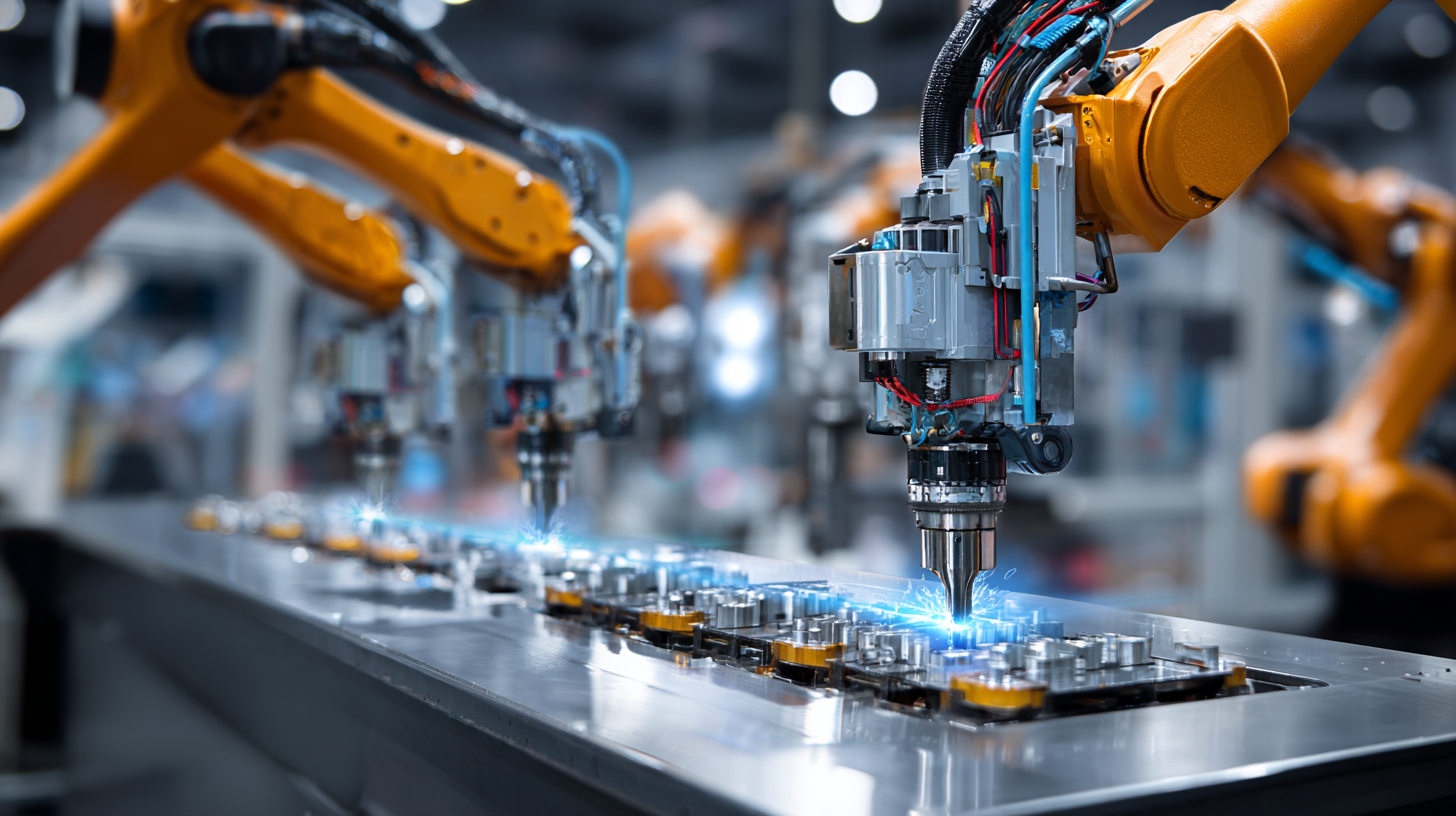

In the rapidly evolving landscape of global industries, manufacturers are at the forefront of transformation, leveraging cutting-edge technologies and innovative practices to redefine how products are made, distributed, and consumed. As we look ahead to 2025, it's imperative to examine the dynamics shaping the market and identify the leading manufacturers driving this change. From automating production lines to integrating artificial intelligence and IoT solutions, these companies are setting benchmarks in efficiency, sustainability, and customer engagement. In this blog, we will explore a selection of top manufacturers that not only excel in their respective fields but also exemplify the best practices for embracing digital advancements. By analyzing their strategies and success stories, we aim to provide insights on how these trailblazers are reshaping industries and what this means for the future of manufacturing as we know it.

As we look ahead to 2025, emerging technologies are poised to reshape industries globally. According to a recent report by Gartner, the adoption of artificial intelligence (AI) is expected to drive $2.9 trillion in business value and create 6.2 billion hours of worker productivity by the end of this decade. Industries ranging from manufacturing to healthcare are already leveraging AI to optimize operations, enhance customer experiences, and innovate products, marking a significant shift in traditional business paradigms.
Moreover, the rise of 5G technology is set to revolutionize connectivity and data exchange, with expected market growth reaching $667 billion by 2026, as per a report from MarketsandMarkets. This advancement will enable manufacturers to integrate the Internet of Things (IoT) seamlessly into their operations, facilitating real-time monitoring, predictive maintenance, and smarter supply chains. The immense data generated will empower companies to make informed decisions, ultimately enhancing efficiency and reducing costs.
Virtual and augmented reality (VR/AR) are also emerging as crucial tools in training and product development. A study by Statista projects that the global AR market will reach $198 billion by 2025, demonstrating its significance in creating immersive training environments and improving product visualization. As these technologies continue to evolve, manufacturers are likely to further integrate them into their processes, leading to transformative shifts in how industries operate.
| Industry | Emerging Technology | Projected Growth Rate (%) | Market Size (Billion USD) | Main Application Areas |
|---|---|---|---|---|
| Healthcare | Telemedicine | 25 | 45 | Remote Consultations, Monitoring |
| Manufacturing | Automation & Robotics | 30 | 70 | Assembly Lines, Quality Control |
| Transportation | Electric Vehicles | 35 | 120 | Commercial, Residential |
| Retail | Augmented Reality | 20 | 30 | Product Visualization, Virtual Trials |
| Finance | Blockchain | 40 | 50 | Cryptocurrency, Smart Contracts |
The evolving landscape of various industries is largely driven by key players who are not just adapting but actively reshaping their respective sectors. From the incorporation of innovative techniques in manufacturing to leveraging sustainable practices, companies in the hydrochloric acid sector and the blowing agent market are setting benchmarks for others to follow. These transformations are pivotal in meeting modern demands and ensuring competitiveness in an increasingly globalized environment.
Tips for companies looking to thrive in this transformative age include embracing technological advancements and sustainability. Staying ahead means investing in research to innovate product offerings and streamline processes. In addition, building partnerships across different sectors can enhance resource sharing and improve market reach, ultimately leading to a more resilient business model.
Moreover, the electric vehicle industry showcases how manufacturers are not only expanding their footprint but are also redefining global trade dynamics. As companies push for international growth amid fluctuating domestic sales, understanding and adapting to the economic relationships that emerge will be crucial for sustained success. Continuous adaptation to market trends and consumer preferences will determine which players will lead the charge into 2025 and beyond.
This chart illustrates the projected growth rates of various manufacturing sectors by 2025. The data indicates significant advancements in sectors such as automation, sustainable practices, and smart manufacturing technologies.
In the rapidly evolving landscape of global industries, innovative companies are redefining best practices to carve their path toward success. One prime example is Tesla, which has not only revolutionized the automotive sector but has also set new standards for sustainability and technological integration. By employing cutting-edge manufacturing techniques and leveraging artificial intelligence in their production lines, Tesla has reduced waste and increased efficiency, illustrating how modern manufacturers can align their practices with environmental consciousness.
Another notable case is Siemens, which has embraced digital twin technology to enhance its manufacturing processes. By creating virtual replicas of physical assets, Siemens is able to simulate and optimize workflows before they even begin. This proactive approach has led to significant reductions in downtime and improved product quality, showcasing a best practice that many companies are now eager to adopt. These examples highlight that innovation, paired with thoughtful strategy and execution, is essential for manufacturers looking to thrive in 2025 and beyond.
In the rapidly evolving landscape of the fashion e-commerce industry, leveraging emerging trends and innovative strategies has become essential for manufacturers aiming for success in 2025. With consumer preferences shifting dramatically in the post-pandemic era, businesses need to adapt their operations and marketing approaches to meet the new demands. For instance, focusing on sustainability and personalized shopping experiences can attract a more conscious consumer base. Data analytics and AI are also paving the way for enhanced customer engagement through tailored recommendations and targeted advertising.

Moreover, the integration of cloud strategies has become a cornerstone for over 60% of companies as they align operations with market dynamics. By embracing cloud computing, brands can improve efficiency, enhance collaboration, and increase flexibility in their supply chains. This transition not only streamlines operations but also enables better data sharing and accessibility, allowing manufacturers to respond swiftly to changing market conditions. As we look towards 2025, those who intelligently harness these trends and technologies will define the future of the fashion e-commerce landscape, showcasing the importance of adaptability and forward-thinking strategies in driving business growth.
As we look towards the year 2025, the future workforce is set to require a diverse array of skills and roles that foster innovation and adaptability across industries. According to a report by the World Economic Forum, by 2025, 85 million jobs could be displaced by a shift in labor between humans and machines, while 97 million new roles may emerge that are more adapted to the new division of labor. This underscores the urgent need for existing and aspiring workers to develop skills in technology, critical thinking, and emotional intelligence.
To thrive in this evolving landscape, professionals should focus on cultivating both hard and soft skills. Technical skills such as AI programming, data analysis, and cybersecurity will be highly sought after; however, interpersonal skills like creativity, collaboration, and communication will be equally critical. Companies are increasingly valuing innovation and adaptation, meaning that workers who can navigate ambiguity and drive change will stand out.
**Tip:** Embrace lifelong learning by enrolling in online courses or workshops to stay updated with emerging technologies. Building a strong professional network can also provide insights into industry trends and opportunities. Regularly assess your skill set and be proactive in seeking ways to enhance it, ensuring you remain relevant in a fast-paced job market.
